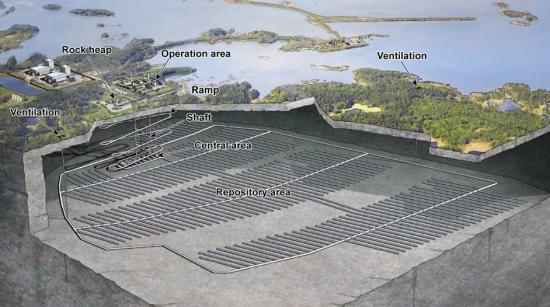Daniel Clery
Source - http://news.sciencemag.org/sciencenow/2012/07/a-million-year-hard-disk.html?ref=hp

Keep out! Scientists are wondering how to warn people far into the future of radioactive sites such as this proposed repository in Sweden. Credit: SKB
It seems these days that no data storage medium lasts long before becoming obsolete—does anyone remember Sony's Memory Stick? So have pity for the builders of nuclear waste repositories, who are trying to preserve records of what they've buried and where, not for a few years but for tens of thousands of years.
Today, Patrick Charton of the French nuclear waste management agency ANDRA presented one possible solution to the problem: a sapphire disk inside which information is engraved using platinum. The prototype shown costs €25,000 to make, but Charton says it will survive for a million years. The aim, Charton told the Euroscience Open Forum here, is to provide "information for future archaeologists." But, he concedes: "We have no idea what language to write it in."
Most countries with nuclear power stations agree that the solution for dealing with long-lived nuclear waste is to store it deep inside the earth, about 500 meters below the surface. Finland, France, and Sweden are the furthest advanced in the complicated process of finding a geologically suitable site, persuading local communities to accept it, and getting regulatory approval. Sweden's waste management company, SKB, for example, spent 30 years finding the right site and is now waiting for the government's green light to begin excavation. It plans to start loading in waste a decade from now, and will be filling its underground pits for up to 50 years.
While the designers of such repositories say they are confident that the waste will be safely incarcerated, the most uncontrollable factor is future archaeologists or others with a penchant for digging. Archaeologist Cornelius Holtorf of Linnaeus University in Sweden showed meeting participants an early attempt at warning future generations: a roughly 1-meter-wide stone block with the words "Caution - Do Not Dig" written in English with some smaller text explaining that there is nuclear waste below. But who knows what language its discoverers will understand in thousands or hundreds of thousands of years—or even if they will be human beings? Holtorf points out that a much earlier attempt to warn off future excavations, the Egyptian pyramids, were looted within a generation. "The future will be radically different from today," says archaeologist Anders Högberg, who is also from Linnaeus University. "We have no idea how humans will think."
In 2010, ANDRA began a project to address these issues, says Charton. It brings together specialists from as wide a selection of fields as possible, including materials scientists, archivists, archaeologists, anthropologists, linguists, and even artists—"to see if they have some answers to our questions." The initial goal is to identify all the approaches possible; in 2014 or 2015, the group hopes to narrow down the possibilities.
The sapphire disk is one product of that effort. It's made from two thin disks, about 20 centimeters across, of industrial sapphire. On one side, text or images are etched in platinum—Charton says a single disk can store 40,000 miniaturized pages—and then the two disks are molecularly fused together. All a future archaeologist would need to read them is a microscope. The disks have been immersed in acid to test their durability and to simulate ageing. Charton says they hope to demonstrate a lifetime of 10 million years.
Researchers have some time to work on the problem because the repositories will probably not be filled and sealed up until the end of this century. "Each country has its own ideas, but we need to get a common approach," says SKB's Erik Setzman. "We technical people can't solve this problem ourselves. We need help from other parts of society."